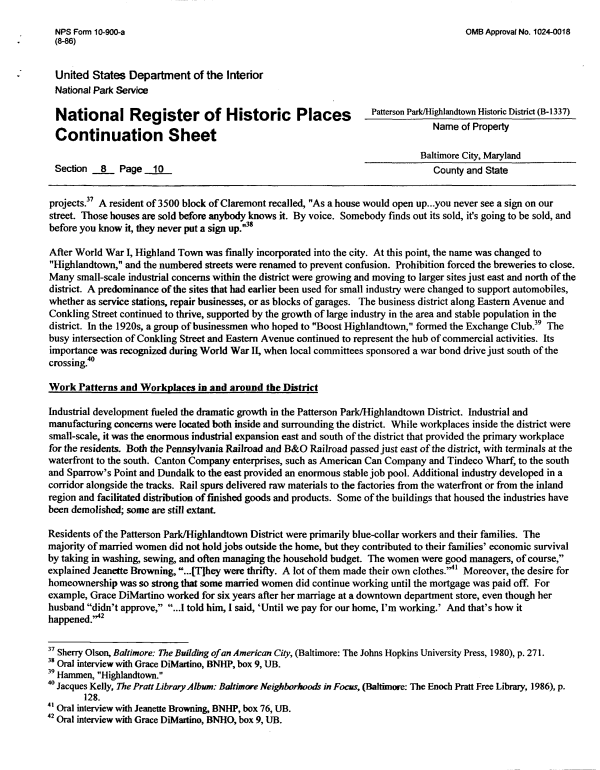 |
||||
|
DEPARTMENT OF HOUSING AND COMMUNITY DEVELOPMENT, MARYLAND HISTORICAL TRUST (Historic Sites Survey) var.d. MSA SE16-3 Image No: se16-3-0105 Enlarge and print image (85K) |
 |
||||
|
DEPARTMENT OF HOUSING AND COMMUNITY DEVELOPMENT, MARYLAND HISTORICAL TRUST (Historic Sites Survey) var.d. MSA SE16-3 Image No: se16-3-0105 Enlarge and print image (85K) |
| NPS Form 1 0-900-a OMB Approval No. 1 024-001 8 (8-86) United States Department of the Interior National Park Service Patterson National Register of Historic Places -» .. x. «•_ A Name of Property Continuation Sheet Baltimore City, Maryland Section 8 Page 10 County and State projects.37 A resident of 3500 block of Claremont recalled, "As a house would open up...you never see a sign on our street. Those houses are sold before anybody knows it. By voice. Somebody finds out its sold, it's going to be sold, and before you know h, they never put a sign up."38 After World War I, Highland Town was finally incorporated into the city. At this point, the name was changed to "Highlandtown," and the numbered streets were renamed to prevent confusion. Prohibition forced the breweries to close. Many small-scale industrial concerns within the district were growing and moving to larger sites just east and north of the district. A predominance of the sites that had earlier been used for small industry were changed to support automobiles, whether as service stations, repair businesses, or as blocks of garages. The business district along Eastern Avenue and Conkling Street continued to thrive, supported by the growth of large industry in the area and stable population in the district. In the 1920s, a group of businessmen who hoped to "Boost Highlandtown," formed the Exchange Club.39 The busy intersection of Conkling Street and Eastern Avenue continued to represent the hub of commercial activities. Its importance was recognized during World War II, when local committees sponsored a war bond drive just south of the crossing.40 Work Patterns and Workplaces in and around the District Industrial development fueled the dramatic growth in the Patterson Park/Highlandtown District. Industrial and manufacturing concerns were located both inside and surrounding the district. While workplaces inside the district were small-scale, it was the enormous industrial expansion east and south of the district that provided the primary workplace for the residents. Both the Pennsylvania Railroad and B&O Railroad passed just east of the district, with terminals at the waterfront to the south. Canton Company enterprises, such as American Can Company and Tindeco Wharf, to the south and Sparrow's Point and Dundalk to the east provided an enormous stable job pool. Additional industry developed in a corridor alongside the tracks. Rail spurs delivered raw materials to the factories from the waterfront or from the inland region and facilitated distribution of finished goods and products. Some of the buildings that housed the industries have been demolished; some are still extant Residents of the Patterson Park/Highlandtown District were primarily blue-collar workers and their families. The majority of married women did not hold jobs outside the home, but they contributed to their families' economic survival by taking in washing, sewing, and often managing the household budget. The women were good managers, of course," explained Jeanette Browning, "...[T]hey were thrifty. A lot of them made their own clothes."41 Moreover, the desire for homeownership was so strong that some married women did continue working until the mortgage was paid off. For example, Grace DiMartino worked for six years after her marriage at a downtown department store, even though her husband "didn't approve," "...I told him, I said, 'Until we pay for our home, I'm working.' And that's how it happened."42 37 Sherry Olson, Baltimore: The Building of an American City, (Baltimore: The Johns Hopkins University Press, 1980), p. 271. 38 Oral interview with Grace DiMartino, BNHP, box 9, UB. 39 Hamrnen, "Highlandtown." 40 Jacques Kelly, The Pratt Library Album: Baltimore Neighborhoods in Focus, (Baltimore: The Enoch Pratt Free Library, 1986), p. 128. 41 Oral interview with Jeanette Browning, BNHP, box 76, UB. 42 Oral interview with Grace DiMartino, BNHO, box 9, UB. |